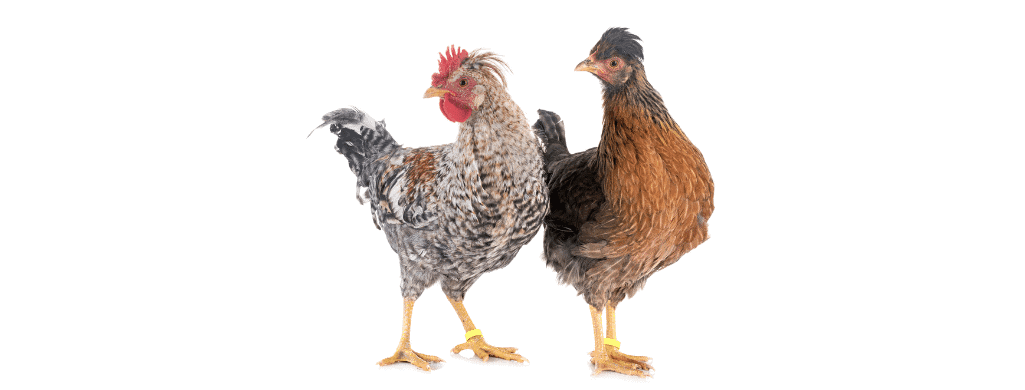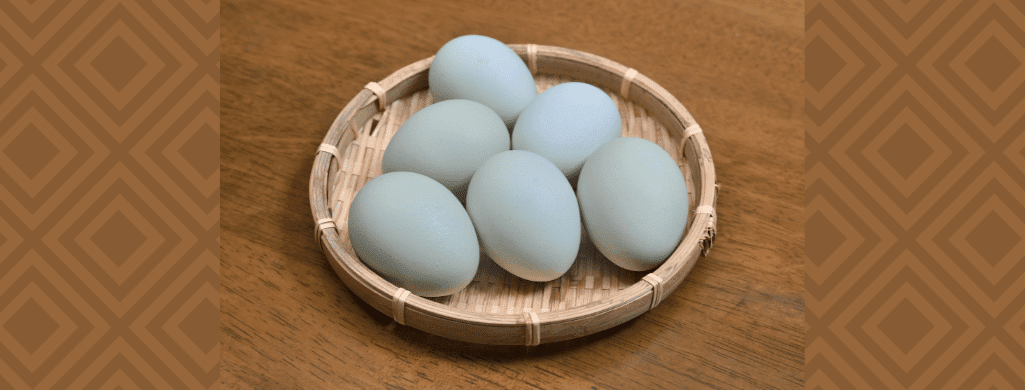Cream Legbars are an autosexing dual-purpose breed of bird.
The brilliant blue color of their eggs has made them especially popular among backyard chicken keepers.
So, when do Cream Legbar chickens start laying pretty blue eggs for you?
Cream Legbars begin laying at around 18-20 weeks of age. Depending on the climate, time of year, and your chicken’s diet, they may start laying sooner or later than this. Many people raising this chicken breed report their pullets laying as late as 6 months (24 weeks).
For the details on this fun chicken, read on!

Table of Contents
ToggleWhat Ages Do Cream Legbar Hens Start and Stop Laying?
The female chicks in your batch of Legbars will grow quickly, but not as quickly as the males.
By 5 months of age, your pullets will be big enough and ready to lay their first egg.
Their exact timing depends on some outside influences, though.
Cold nights and days, for example, tend to set new layers back a bit.
Having too little protein or calcium in their diets can have the same effect.
If you struggle to find good quality layer feed in your area, we recommend this one sold on Amazon.
The protein percentage on this feed is 16%, and it’s a non-GMO pellet.
Unfortunately, because the feed is organic and so high in protein, it is also quite expensive.
Whereas some conventional feeds are sold for less than $20/50lbs, this feed is $25/10lbs.
Only buy something like this if your new blue egg layers struggle to get all their nutrients.
Cream Crested Legbar hens keep laying until about 5 or 6 years of age, at which point their production will slow down and stop.
Many other breeds follow the same pattern and quit laying at age 5 or 6.

Signs Your Cream Legbar Is Ready To Lay
Want to know when the pullets in your flock are getting ready to lay? Look for these exciting signs!
Your bird is:
- Singing the egg song
- Maturing physically
- Sitting in nesting boxes
Not all pullets or full-grown hens sing the egg song. However, it is a pretty common occurrence in most breeds.
Even if your young layers haven’t quite started laying yet, they may sing for other hens in your coop who do lay already.
Singing for other layers is a sign of readiness as well.
Another indication your birds will give you is their appearance.
When a Cream Legbar is reaching the age to become your next prolific layer, its large-size single combs start to swell and get darker in color.
While your female chicks are growing, their combs are pink. Once they are old enough to start laying, their combs turn red!
One final way to discover whether or not your pullets are ready to lay is by watching their behavior.
A pullet you see sitting in the nesting boxes or squatting a lot is likely to start laying to show off its unique egg color!
Cream Legbars are active foragers who spend lots of time roaming around outside the coop. This is why we recommend giving your Legbars ample space to roam.
In fact, it’s rare to have a broody Legbar hen.
This is why settling in their nesting box is a sign they are preparing to lay an egg.
Further Reading: Are Cream Legbar Chickens Broody?
Are Cream Legbars Good Layers?
Cream Legbars are natural foragers and prolific layers, producing anywhere from 150-250 eggs per year.
Remember, different hatchery strains will be more or less productive. Shop from reputable breeders whenever possible.
Granted, this breed of chicken is sometimes hard to come by in the US, even though it’s a popular, beautiful bird.
They could have different laying habits depending on where you purchase your Crested Cream Legbars.
This chicken breed is an unpredictable winter layer as well. Some hens are excellent winter layers, while others stop laying in colder months.
Especially cold winters are tough on all the birds in your backyard flock.
Related Reading: Are Cream Legbar chickens cold-tolerant?
But Cream Legbars are more likely to take a break from egg production when they struggle to maintain their body heat.
In the end, whether or not you get a winter layer will depend on the bird you’re raising.

What Do Cream Legbar Eggs Look Like?
Many bird keepers these days enjoy caring for a variety of poultry breeds with colorful feathers and eggs.
Before you get Cream Legbars from a hatchery or breeder, let’s answer the million-dollar question:
Do Cream Legbars really lay blue eggs?
They sure do!
In fact, this is one of only a few breeds with such a beautiful and unique egg color.
Other colored egg layers include the Araucana, Ameraucana, and Easter Eggers.
Though a slow starter, the Cream Legbar is a generally healthy breed. Their eggs look odd initially, but this isn’t a health concern.
It is totally normal for any healthy bird in your mixed-breed flock to lay smaller, off-color eggs when they first start to lay.
The green-blue of your Cream Legbar eggs may be a darker color at first.
Are Cream Legbars Autosexing?
Maybe you buy your baby chicks from a hatchery or breeder. Maybe you hatch them yourself using an incubator.
Either way, it’s so exciting when you find autosexing chicks!
Cream Legbar roosters and hens look different just hours after hatching.
If you end up with some roosters, consider raising them until culling age.
Further Reading: Can you eat Cream Legbar chickens?
Are Cream Legbars Late Bloomers?
Cream Legbars start laying at around 5-6 months of age and stop laying after about 5-6 years.
They are very productive layers when mature, but only some of them are winter layers.
Don’t worry about any strange shapes or colors to your Legbar’s first egg. This is normal!
To ensure your birds start laying before too long, get them a high-protein feed like this one.
With your help, your flock will be full of thriving, healthy birds!
How useful was this post?
Click on a star to rate it!
We are sorry that this post was not useful for you!
Let us improve this post!
Tell us how we can improve this post?
